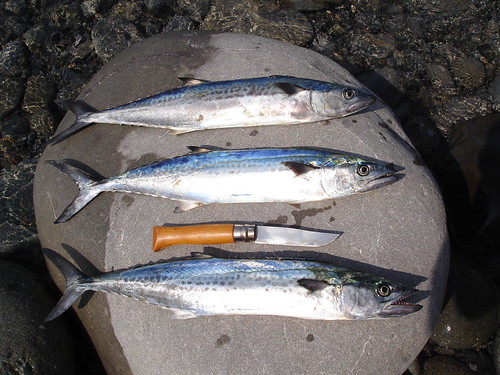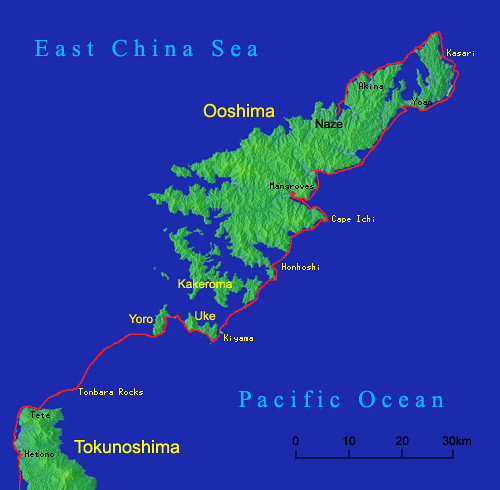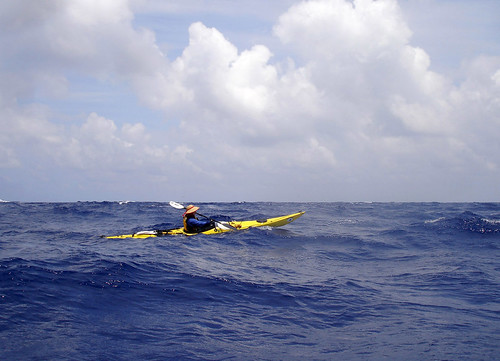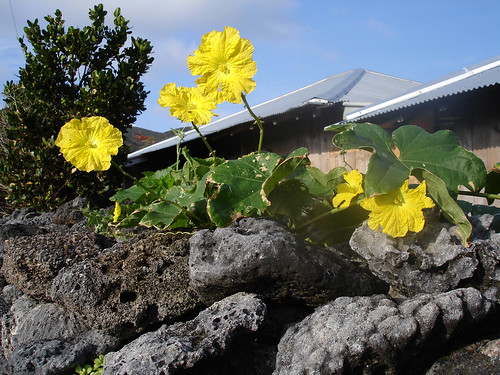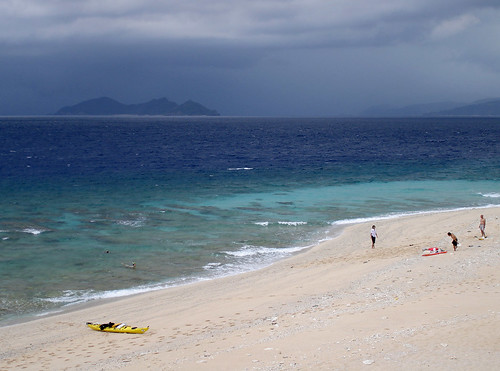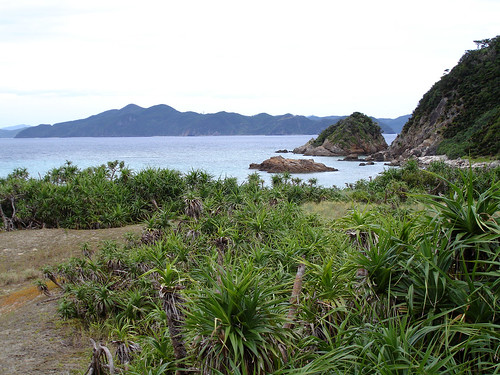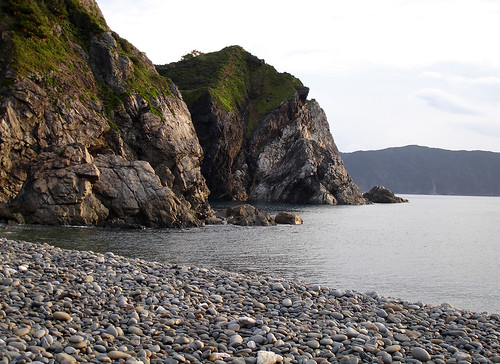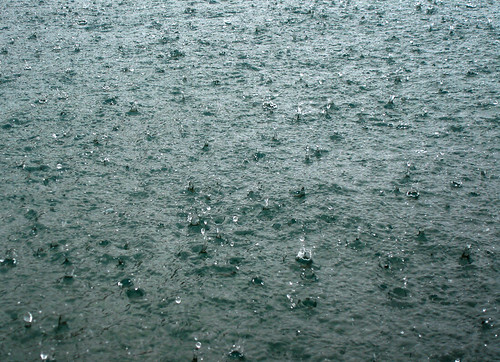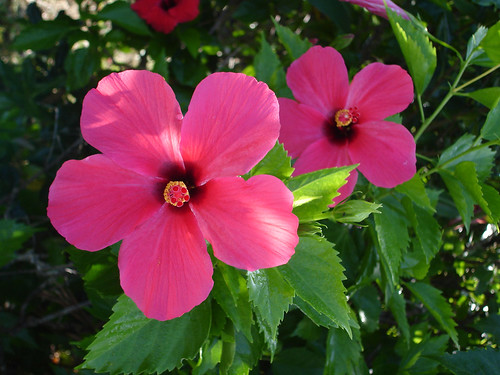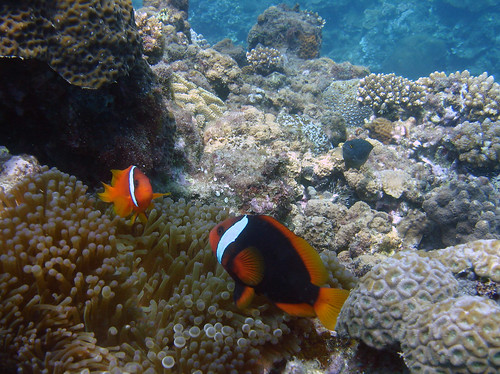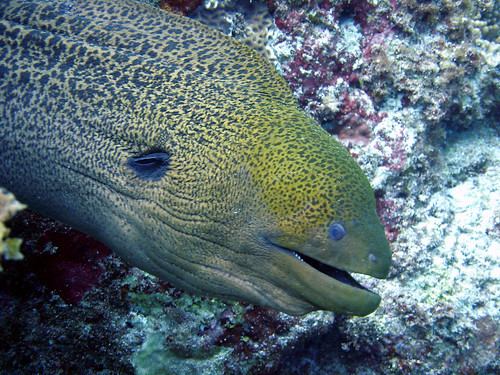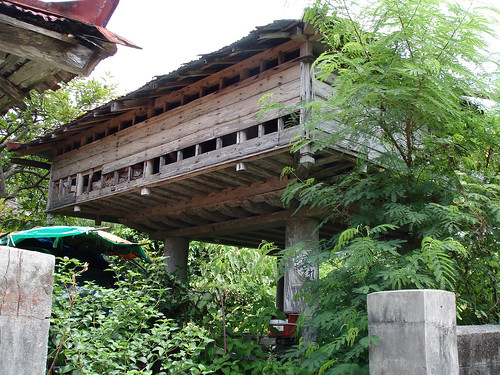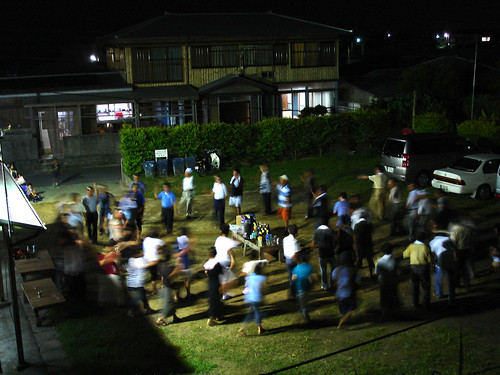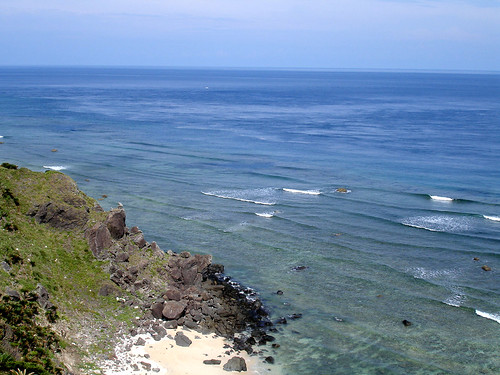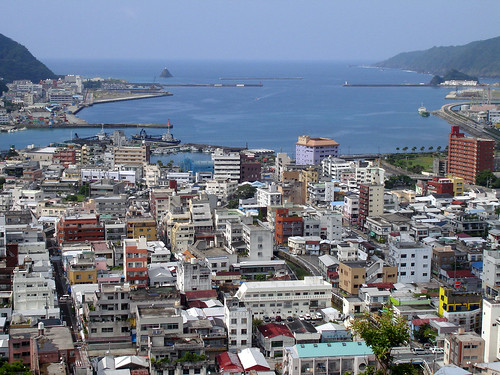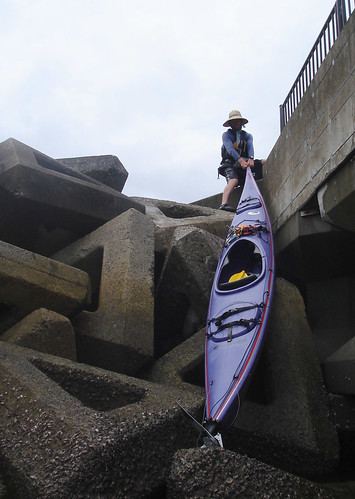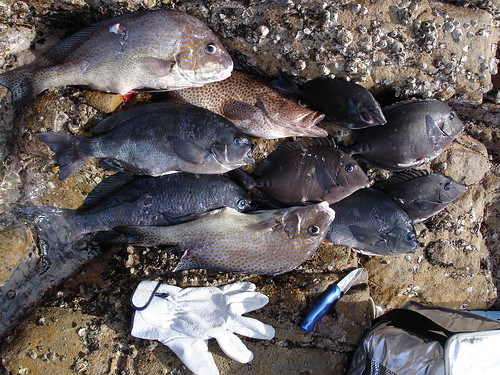Saturday, October 29, 2005
Thursday, October 27, 2005
Wednesday, October 26, 2005
blue
“Aoi da, Aoi da.” “It’s blue. It’s blue.” Looking down into the sea from the ferry, a father repeats this to his 9-year-old son at least five times. The son does not seem particularly interested. The second and third week of August is Obon season, when tens of millions of people return to their ‘furusato’ (hometown) to visit their aging parents and pay their respects at the family graves. For this man, seeing the blue sea fills him with nostalgia, for the sea in his new home of Yokohama or Nagoya resembles more the miso soup he eats every morning for breakfast. He knows that his living environment is polluted, though as a modern urbanite he has probably convinced himself this is a price we pay for progress. Here, looking straight down into the water, he sees in nature the kind of brilliant blue otherwise seen only on a blank computer screen. His yearly return to his hometown has also come to symbolize a fleeting return to things purer and cleaner, the way they used to be. All this seems lost on his son, who has grown up in the city and through lack of example or appropriate education, does not understand the finer points of a clean living environment. Unnoticed by the man or his son, a sea turtle floats up, takes a few breaths, and dives again, looking small from the top deck of the ferry.
Wednesday, October 19, 2005
Last big crossing
Only one more big crossing would take us to Amami Ooshima, the final island of our journey. Although this was a relatively short crossing of 25km, leaving the security of Tokunoshima’s coast was daunting. The waves in places were around 2 meters, caused by the north-west wind in opposition to the westward setting Kuroshio Current, which at 4km/h seemed faster here than ever. Our forward speed averaged about 2.5 km/h for hours on end in spite of hard paddling and wave surfing. Yoro Island seemed forever out of reach. Resting was out of the question, as any break equaled an appalling loss of ground and besides the sea was too rough for a swim or even bringing the kayaks together. After a long day, we arrived exhausted but high at the beach in Yoro’s only village. We were received enthusiastically by a bunch of young kids playing in the sea.
yoro
This island village is unique, being perhaps the most isolated community in Kyushu.
The closest civilization is about an hour away by boat, and no other settlements exist on this small island. Some of the village’s narrow streets are lined with stone walls (ishigaki) and retain at least some of the charm of years gone by. We strolled around the tiny place several times, and bought sodas at a store run by a blind woman who talked nonstop in a dialect that left us completely bewildered.
hanmya
The next morning we noticed large cumulus clouds brewing in the sky. We set out for the nearby, uninhabited island called Hanmya. As we explored the unusual sand beach that extends up the islet’s steep slope, a nasty squall brewed up to the west and attacked the island with strong winds and rain. After 30 minutes of raging weather it cleared and we continued on our way. Passing to the east of Ukejima we spotted some dolphins playing in the current.
kiyama
Uke and Kakeroma are two other sparsely populated islands lying close to each other and close to the main, large Amami island. These and numerous smaller uninhabited islands and rocks are all part a complex rias landscape that makes for great kayaking. Calmer inland waters exist where the islands face each other; this is also where most villages are located. Blessed with calm weather, we instead chose to skirt the Pacific fringe of the archipelago, with its uninterrupted wilderness. Wild goats scaling the precarious cliffs overhead were the principal inhabitants here. The coastline was riddled with enjoyable rock gardens and labyrinthine caves we could not resist exploring. Perfect campsites abounded on beaches and grassy shelves where the coast was less steep. Though it was the height of holiday season, the whole place seemed completely deserted.
honhosi
Early the following day, we finally met some people at the Honhoshi beach, where a grandiose attempt was made to turn a natural beach of smooth round pebbles into a tourist attraction. Cresting the low narrow isthmus on foot revealed an expansive new park, which had been invisible from the Pacific side. A small group of touring climbersc was just waking up to the early morning’s bright sunshine, while one or two elderly citizens walked briskly for exercise upon the sidewalks already overgrown here and there with dense weeds. The presence of these few humans did very little to break the solitude of this expansive open ground.
rain
The coast stretched northeastward in rocky capes enclosing inlets and bays. Small villages nestled in the more protected places, but the promontories remained wild. The Pacific was calm but large clouds were again building in the sky. Around noon isolated thunderstorms began rolling through; we paddled on through the squalls but kept the coast close at hand in case a big wind blew up like it did yesterday.
Mangrove estuary
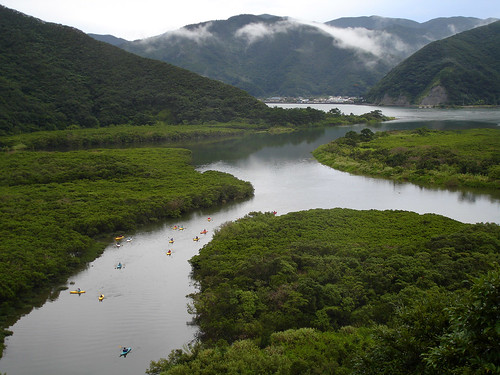
Kayak tours of this aquatic labyrinth are particularly popular, as we found out when we surprised a group of floating tourists at the end of a long and sinuous channel through the dense jungle. Their guide was standing chest deep in the muddy water explaining at length details of the swamp’s intricate ecosystem. We had fun exploring here and there; in the end we were glad we had made the 15km detour.
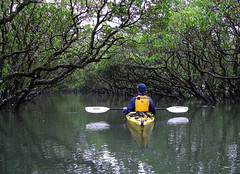
Tuesday, October 18, 2005
hibiscus and Adan
Continuing along the coast, we saw its slopes become gentler. Long beaches and coral reefs, rare until now, had appeared along with civilization along the shore.
Shrubberies of Hibiscus, the island’s designated flower, graced the semi-deserted parks and picnic areas where we made occasional landfall. 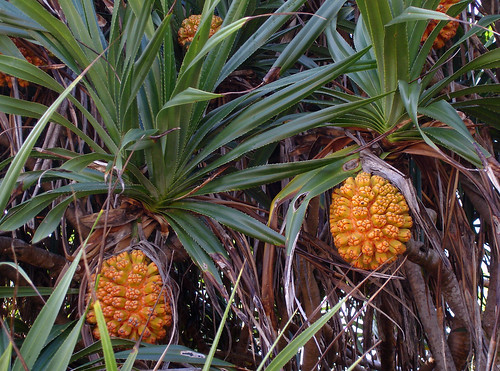
A fruit called “Adan” which resembles a pineapple yet inedible lined the sandy embankments. Soft drink vending machines (jidohanbaiki) had reappeared, bringing us back to the full convenience of civilization.
Finding Nemo
takakura
The coast had gradually become flat and more populated, with continuous long beaches and outlying reefs. The sandy bottom gave the sea a beautiful turquoise color. As character of the coast softened, so did our resolve to forge on relentlessly. We had been covering good distance each day, afraid to be pinned against the coast for days by the swell of a typhoon. Now, with only an easy day of Pacific coast left, and no typhoons in sight, we relaxed our pace. We snorkeled at midday, walked around the seaside villages in the evenings, and camped and fished in small harbors. Although we saw the typical signs of overbuilding everywhere, progress in this very rural area has been somewhat slower than elsewhere. Old wooden structures, such as this ‘takakura’ (high storehouse) with its high smooth pillars to keep out rodents, still survive here and there.
dance
One night we happened on a traditional summer dance performed by local folk in front of the public hall in the village of Kasari. In this dance the villagers form a circle; some women carry drums and lead the circle’s movements while verses of old songs are sung alternately by women and men. Gradually the pace of the drums quickens until no one can keep up; then a new dance begins after a short break. The locals received us enthusiastically and we were invited to join in. Afterwards, we accepted invitations to several parties, with drinking, singing and playing of the traditional banjo-like shamisen. Visitors here in the islands, we were told, bring good luck and blessings to a house just by coming; that is why everyone was so excited to have us over. We made some instant friends, including several young women who had been leading the dance. We talked with them into the night about their reasons to have stayed here while all other young people have already left for the ‘mainland’. We were impressed to hear that they stayed because they wanted to learn the local songs and dances from the village’s elders, the last people who know them well. Evidently this centuries-old tradition is to continue at least another full generation.
kasarizaki
By mid-morning of the next day we rounded our journey’s northernmost point, Cape Kasari. A climb to the lighthouse via a narrow path revealed an expansive view of the Pacific meeting the East China Sea; the two unequal waters swirl with turbulence upon meeting. As luck would have it, the current now seemed to be from the southwest and would, of course, conspired to slow our progress. Watching some debris drifting along, we realized that were it not for the protective shallows inside the reef, we would hardly be able to make progress against the fast-moving water. If one were to continue island-hopping, this current, plus the nearly 100km of open water to the next nearest island, would present a formidable obstacle. 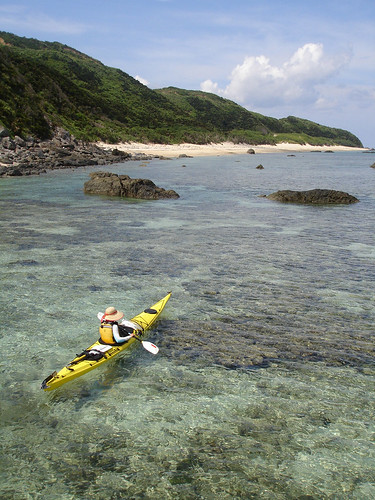
We contented ourselves with hugging the shore, keeping a stiff pace and trying to cover distance before the falling tide would leave us stranded on top of the shallow reefs.
Monday, October 17, 2005
naze
We were now on the home stretch and in another easy day we reached our final destination: the port city of Naze, from where we would be making our departure.
Naze, with a population of 40,000 is by far the largest city between here and central Okinawa. Being the same size as our base town of Hondo in Amakusa, we could not help drawing comparisons and of course, we decided Naze was much nicer though to the casual eye its mish-mash of nondescript concrete buildings looked thoroughly unremarkable. One of the good points, however, was evident on approach: a sewage treatment plant tucked away by the seaside where the city suddenly ended and wilderness began. As a result, the harbor was the cleanest we’d ever seen; the water was clear and teeming with fish. At the ferry dock, the bottom was so clearly visible that the ship seemed to be sure to scrape it on approach.
Sunday, October 16, 2005
heave
In one last brutish effort, we hauled the boats onto the dock at a fortuitous pile of tetrapods. Our paddling journey was over, and we could not believe our luck: no seriously bad weather in the middle of typhoon season, with two typhoons passing by just far enough not to be a hindrance. During the last two weeks the sea, its shores and its people had become a permanent part of our world leaving us feeling greatly enriched.
Tuesday, October 04, 2005
tairyou
Last week we accidentally discovered the sport of spear fishing. Noticing the simple, cheap, metal-tipped and elastic-equipped implements at the fishing store, we thought it might be fun to give them a try. Well, it seems this sport has a very fast learning curve. Yesterday in just 2 hours I hauled in 8kg of choice fish off the rocky west coast of Amakusa. I felt a bit awkward hauling in one fat fish after another within sight of the sport fishermen perched on the rocks, who in the meanwhile caught nothing. Obviously it is an advantage to be able to see the fish underwater! I am not sure why everyone doesn’t do it this way, though that’s just as well, because then there’d probably be no fish left. Perhaps not everyone can snorkel 10 or 15 meters deep, which is required to get sizeable fish, though there are plenty of people who dive deeper for abalone, etc…but be that as it may, we are in the lucky position once again where we have the entire sea to ourselves! Quite excited by this, we went spearing four times this week, in various places but always with consistent results.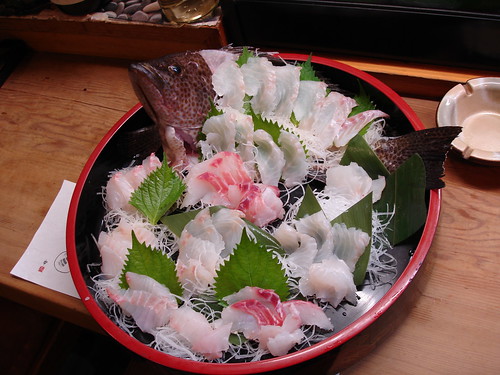
By the evening, the catch had been converted into mountains of sashimi at our friendly neighborhood sushi shop. The master said this catch would be worth about $100 at the fish market, as some of the fish are rarely caught and are much prized as a delicacy. I wonder if I should quit my day job! As it is, quite a few students at the school where we teach went home delighted with a fish, and some classes turned into all-you-can-eat sashimi fests. Though we’re not seriously thinking about selling the fish (yet!), contrary to habit we did not eat out at all this week, thusly saving ourselves at least $100. With a gut full of raw fish, even the nearby KFC has somehow lost its appeal.

